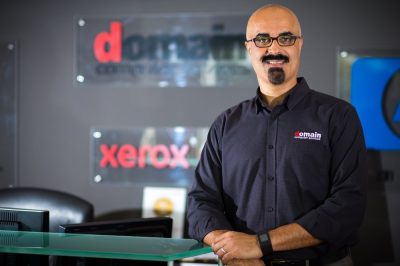Innovation and STEM Fields
For America to compete in the 21st century, we need a robust innovation economy—which requires a workforce skilled in the science, technology, engineering, and math (or STEM) fields. Yet American students are not entering those industries in sufficient numbers, and the United States is projected to face a shortage of one million STEM workers by 2022.1 Foreign-born students frequently gravitate towards STEM disciplines, making up roughly one out of every three individuals earning graduate-level STEM degrees each year. Our broken visa system, however, makes it difficult for many of them to stay after graduation—a reality that hurts the ability of our employers to expand and create more opportunity for American workers. 1 President’s Council of Advisors on Science and Technology, "Engage to Excel: Producing 1 million Additional College Graduates with Degrees in Science, Technology, Engineering, and Mathematics," February 2012. Available online.

New Research Shows Banning In-State Tuition for Dreamers Could Cause Missouri to Miss Out on Millions in Additional Tax Revenue and Spending Power Every Year
As the Missouri Legislature considers prohibiting access to in-state tuition for Missouri Dreamers, new data shows there are significant economic benefits the state would bypass. Jefferson City, MO – Today New American Economy (NAE), a bipartisan immigration research and advocacy organization, released a new study showing how offering in-state… Read More

From coding to coaching — an immigrant entrepreneur makes it his mission to help the next generation succeed
Rashaad Bajwa arrived in the United States when he was 3 years old. Learning English was easy, given his age. And his parents, educated in British schools in Pakistan, spoke English at home. But he still lived the immigrant experience. “I still am,” he says. “Even though I grew up… Read More

New Data Shows Immigrants Make Up More Than 60 Percent of Middlesex County’s STEM Workers and Nearly Half of Business Owners
Immigrants held $9.4 billion in spending power– 42.8 percent of the total spending power in the county–and contributed more than $4 billion in taxes in 2018. Middlesex, NJ — Despite making up 34.5 percent of Middlesex County’s population, immigrants accounted for 64.4 percent of the county’s Science, Technology, Engineering,… Read More

New Data Shows Cedar Rapids’ Immigrants Accounted for Nearly Half of the County’s Total Population Growth
A new report finds that immigrants accounted for 47.1 percent of total population growth in Cedar Rapids between 2012 and 2017, according to new research from New American Economy (NAE). Read More

New American Economy on the RELIEF Act of 2019
New American Economy explains the merits of the RELIEF Act of 2019. Read More

Immigrant Engineer Driven By a Call to Serve His Country and Community
Kamal AlSawafy was 9 years old when he arrived in Dearborn in 1997. Three years earlier, his family had fled Iraq, where his father, a construction worker, risked imprisonment and torture for his failure to support then-President Saddam Hussein. Now they had been granted refugee status and joined family in… Read More

New Data: Wayne County Immigrants Contributed More Than $10.5B to GDP
Detroit, MI – Immigrants contributed more than $10.5 billion to Wayne County’s GDP in 2017, according to new research from New American Economy (NAE) in partnership with the Office of the Wayne County Executive and Wayne United. In addition to their financial contributions, including $430.5 million to Social… Read More

New Report Shows Immigrants in Genesee County Paid More than $100 Million in Taxes in 2017
GENESEE COUNTY, MI – Immigrants paid more than $100 million in taxes in Genesee County in 2017, according to new research from New American Economy (NAE) in partnership with the City of Flint Mayor Karen Weaver‘s Office and the International Center of Greater Flint. In addition to their… Read More

New Data Shows Immigrants Are 40 Percent of Business Owners in Dallas County
DALLAS, TX – Immigrants accounted for 40 percent of Dallas County’s business owners in 2017, according to new research from New American Economy (NAE) in partnership with the North Dallas Chamber of Commerce. In addition to their financial contributions, which included paying $2.8 billion in federal taxes and… Read More

New Data Shows Toledo and Lucas County Immigrants are Offsetting Local Population Loss
Toledo, OH – Immigrant community members who live in the City of Toledo and Lucas County have partially offset local population loss, according to new research by New American Economy (NAE). The report, which was published in partnership with Welcome Toledo-Lucas County (TLC), a local cross-sector initiative housed… Read More
Outsize Role in the Workforce
Immigrants punch above their weight class in the STEM fields, making up far larger portions of the STEM workforce than they do the U.S. population overall. This dynamic is particularly pronounced in several states. In New Jersey, for instance, immigrants make up almost two out of every five STEM workers, while accounting for only one in five of the state’s residents.
States with the Highest Share of Foreign-Born STEM Workers, 2014
Labor Shortages
In recent years, many U.S. employers have struggled to find enough STEM workers. This lack of manpower has real consequences for the economy—making it difficult for firms to expand and create jobs for American workers at all skill levels. In several specialized fields, like physical science and software development, the unemployment rates of U.S.-born STEM workers are particularly low, indicating there are simply not enough U.S.-born workers to meet the needs of employers.
Take a look at our latest research about the shortage of STEM workers.
U.S. Citizen Unemployment Rates in STEM Fields Most Heavily Reliant on Immigrant STEM Workers, 2014
Earning STEM Degrees
International students make up a large share of STEM graduate students. In 2014, more than a quarter of STEM master’s degrees and more than a third of STEM Ph.D. degrees went to students in the country on temporary visas. Meanwhile, the number of American citizen and permanent resident students pursuing graduate degrees in science and engineering fields actually fell by 6.3 percent between 2010 and 2013.2 Our broken immigration system means that many of these international students will struggle to remain in the country after graduation, despite employers needing them.
Sources:
2 National Science Foundation, Science and Engineering Indicators, 2016, Appendix Table 2-25. Available online.
Share of Ph.D.'s in Selected Fields Going to Students on Temporary Visas, 2014
States Graduating the Most STEM Students on Temporary Visas, 2014
States Needing STEM Workers
While every state was short STEM workers in 2015, the shortage was particularly acute in North Dakota and South Dakota, where employers listed 87 and 71 STEM positions, respectively, for each unemployed STEM worker. These are gaps that immigrants could help fill. In South Dakota, for instance, immigrants made up just three percent of all STEM workers in 2015, one of the lowest shares in the country.
States with Greatest Shortages of STEM Workers, 2014
Creating U.S. Jobs
Rather than reduce the number of jobs available to American workers, foreign-born STEM graduates often create additional jobs for U.S.-born workers. Research shows that when a state gains 100 foreign-born STEM workers with graduate-level training from a U.S. school, an average of 262 jobs are created for U.S.-born workers there in the seven years that follow.3 More specifically, the temporary visa (H-1B) program for high-skilled workers is also linked to job creation for American workers and economic growth. However, the current system fails not only to provide visas that companies need to grow, but also to protect against fraud and abuse.
Sources:
3 Madeline Zavodny, “Immigration and American Jobs,” The Partnership for a New American Economy and the American Enterprise Institute, 2011. Available online.
States that Stand to Gain the Most from Retaining More Foreign-Born STEM Graduates
The Impact of our Broken Immigration System
Since the recession, some of the most robust growth in high-wage, American jobs has occurred in cities. The high-tech companies fueling this growth cannot succeed and grow, however, without qualified STEM professionals—a group that can be difficult to find. An annual cap on the number of available green cards and H-1B visas hinders efforts to hire immigrant STEM professionals when no American workers are available. At right, we explore how the H-1B requests for computer-related workers that did not make it through the 2007 and 2008 H-1B visa lotteries impacted wages and the number of jobs available for U.S.-born tech workers in the two years that followed.4
Sources:
4 Partnership for a New American Economy, “Closing Economic Windows: How H-1B Visa Denials Cost U.S.-Born Tech Workers Jobs and Wages During the Great Recession," June 4, 2014. Available online.
Metropolitan Areas Hurt Most by 2007 and 2008 Denials in the H-1B Lottery
Driving Innovation
International STEM students and graduates are behind some of America’s most impressive innovations, from artificial skin to moldable metal. Studies show that immigrants with an advanced degree are three times more likely than U.S.-born graduate degree holders to file a patent. When universities increase their share of international students, they often receive more patents—boosting revenue and creating more opportunities for all students.
Share of Patents Awarded to Top Patent Producing Research Universities with at Least One Foreign-Born Inventor, 2011
Make a contribution
Make a direct impact on the lives of immigrants.
